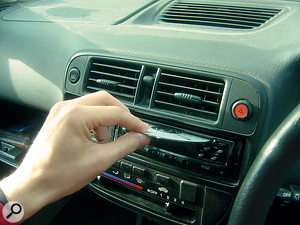Hugh Robjohns
Tracks that I mix in my home studio tend to sound really bad in my car, but when I correct the mixes so they sound good in the car, they sound awful over my monitors. I've got OK monitors and some acoustic treatment at the mirror points, so what's going wrong?
Jake Ramirez via email

SOS Editor In Chief Paul White replies: That's a question with many possible answers. While car stereos aren't going to be the most neutral-sounding replay systems in the world, they're not likely to be the cause of this problem and mixing specifically to sound good on them is not the best approach: you need to be able to trust what you hear in the studio. So — skipping politely over the questions of the skill level of the mix engineer! — I suspect you need to look more closely at your existing acoustic treatment and room setup.
It's great if you already have adequate acoustic treatment at the mirror points (by adequate I mean 50 to 100 mm foam or mineral wool, not carpet!); the room should behave reasonably well in the mid- and high-frequency ranges. But be aware that such treatment has little effect below 300Hz or so. Things that can compromise your mid and HF response, even when the room is treated, include having hard, reflective objects in front of the speakers, such as the sides of computer monitors, or having the speakers placed far back on a hard desktop that is able to bounce sound back to your listening position. Wobbly speaker stands also cause problems, though this will be mainly at the bass end.
Most of the serious mix-translation problems are due to large peaks or dips in the bass response of the monitors, and to help you minimise this sort of problem I'll run through a few key points.
Firstly, always have the monitors facing down the length of a domestic-sized rectangular room, not across its width, and make sure the tweeters are aimed at or just behind your head. If you work across the room, the bass will usually be very inconsistent, and will appear to change in balance as you move around the room. We've never found any practical way around this in smaller rooms (especially those with solid brick orJust how do you make sure your mixes translate to consumer systems such as car stereos?Just how do you make sure your mixes translate to consumer systems such as car stereos? concrete walls) so my advice would be that, whatever the inconvenience, aim your monitors down the length of the room at least while mixing, even if you have to move them to get through the door!
Small rooms that force you to sit close to the centre of the floor are often a problem too, as a large bass null often occurs at that point, especially in near-square rooms, or ones where either wall dimension is similar to the height of the room. In cube-shaped rooms the lower octave or so of the bass often vanishes completely when you sit in the centre of the room, so make sure you move from that spot when evaluating mixes.
For similar reasons, try not to sit with your chair very close to a wall when mixing, as the bass reinforcement there will fool you into thinking there's more bass in your mix than there really is; sitting close to corners is even worse.
If you can avoid the above situations, then placing your speakers on speaker platforms or solid stands will help firm up the bass end, and you can always check for bass problems by running a simple chromatic sine-wave test by playing a sine tone over the bottom couple of octaves from, say, 50 to 200 Hz. If you hear any significant peaks or dips, then try moving the speakers a few inches in any direction and run the test again. Small changes here can often make a useful improvement.
Another thing to check if you're using small studio monitors is that you don't have a lot of low end in your mix that you can't hear on your speakers. A spectrum analyser plug-in will show you what's going on, even if you can't hear it, while double-checking your mixes on decent headphones is always a good way to confirm that the balance is right and that the room isn't influencing the sound.
Once you get things in the right ballpark, active-speaker correction EQ systems such as IK's ARC can help tame excessive peaks. Finally, if you want to be sure what your studio sounds like, make a point of listening to commercial material in your studio, and get used to the way it sounds. Mike Senior's article on what to look for when creating a reference CD (http://sosm.ag/sep08-reference-cd) is well worth looking up in this respect.
No comments:
Post a Comment